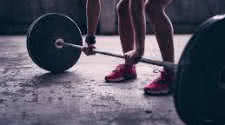Study: Does Maximum Power Truly Equal Maximum NEW Muscle Growth?

Optimal Methods for Ultimate Success and Progress in the Gym
Few can deny that the way to increase lean body mass is to lift progressively heavier weights. Yet observations suggest that neither
the heaviest loads nor the lightest are the most effective for stimulating growth. Powerlifters and Olympic weightlifters, for instance,
frequently sport muscles that are much less developed than those of serious bodybuilders. While the lifters tend to train at a high
percentage of maximum capacity, they don't generally train at 100 percent, and the bodybuilders, who have bigger muscles, usually use
loads that are smaller, proportionately, than those the strength athletes use.
The idea that the heaviest and lightest loads are less effective in producing strength gains was demonstrated in a 1962 study. The
subjects were divided into six groups, each performing the bench press with a different percentage of maximum load. The percentages
used were 95 (two-rep max), 86 (four-rep max), 78 (six-rep max), 70 (eight-rep max), 61 (10-rep max) and 52 (12-rep max). The results
showed that the subjects who used four-, six- and eight-rep-max loads made significantly greater strength gains, as measured by a one-rep
max, than the others.
Although this study has been criticized by some researchers since that time, other experiments have yielded similar results. In one study
subjects who trained one arm with six sets of 10 to 12 reps and the other arm with six sets of two to three reps showed greater gains in
both strength and mass with the moderate reps. By the early '8Os many experts were suggesting that loads of five-to-six reps max were
optimum.
The Maximum Power Stimulus Theory
One 1992 study tagged the optimum load to maximum power. By definition, maximum power is the maximum rate at which work can be done; in other words, the maximum rate at which energy is converted into work. If the heaviest loads yielded power that was too low to produce the greatest gains, maybe the weight wasn't the only factor involved in the metabolic equation that produces strength gains.In order to test the theory, the researcher worked with two groups of physical education majors, one of which performed strength training and the other, power training. The object of the experiment was to see which form of training was most effective in producing gains in strength via tests that consisted of performing machine shoulder presses as quickly as possible. Maximum power was defined as the greatest force and velocity produced with any weight, while strength was defined as the heaviest weight that could be lifted.
The strength group performed five sets of five reps using 75 to 95 percent of the pretest strength score, with subjects setting their own pace, or velocity, and length of rest between sets. Training for the power group involved lifting as quickly as possible using a load one increment heavier than the one that gave the subject maximum power. In this case subjects could take as much rest as they wanted between sets. The results suggested that the subjects who trained faster made the most gains; in other words, maximum power was indeed the strengthening stimulus.
High-Velocity Strength Training
So the riddle has been solved. To stimulate maximum hypertrophy, you need to generate maximum power, and nothing else will do it, right? Well, not exactly. Let's take a closer look. First of all, generating maximum power with conventional bodybuilding equipment like barbells, dumbbells and resistance machines can increase your risk of injury. What's more, there's still no definitive proof that high-velocity/high-power movements, while effective for stimulating strength gains, provide the best stimulus for muscle growth.In a rapid repetition the load is not a function of the speed but of the effort to overcome inertia and accelerate the weight. Once that happens and the required speed is achieved, the accelerating force gives way to a counter force in order to slow down, or decelerate, and bring the weight to a rest. Thus, the period of elevated load intensity is short, making exercise less than optimum for inducing hypertrophy.
Even so, you may be interested in using high-velocity movements for other sports applications, in which case there's a somewhat safer training solution. A 1993 study looked at whether it's actually necessary to follow a high-velocity repetition through its complete range of motion in order to get the velocity-specific response, and the results caused the researchers to suggest that athletes may be able to improve high-velocity strength by simply attempting to lift very heavy weights rapidly. The researchers warned, however, that this sort of training, involving contractions characterized by rapid force developing into relatively peak force, may be more likely to cause strains and tears. So if you're looking to include this type of training in your program, you should introduce it slowly and gradually.
The Conclusion for Bodybuilders
The precise stimulus for the muscle hypertrophic response that bodybuilders seek remains, for the most part, a mystery. While the maximum power stimulus theory may hold some of the answers, the evidence isn't all in yet. The proper equipment could make maximum power training more productive. For example, with elacity held constant by external means such as isokinetic resistance machines, a maximum effort doesn't result in an accelerated movement and accompanying drop in motor unit involvement as described above. And while there's no definitive evidence that maximum power is a prerequisite for lean tissue gains, experience indicates that those machines may be effective at stimulating hypertrophy for other reasons.Studies like the ones described here give us ideas for our own experiments. Apply the above suggestions to your own laboratory, the gym, and you may arrive at the answers you're looking for sooner than you think.